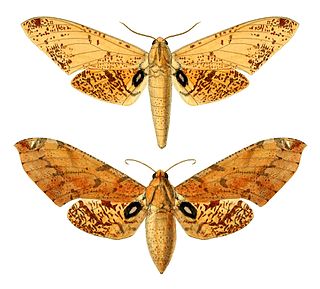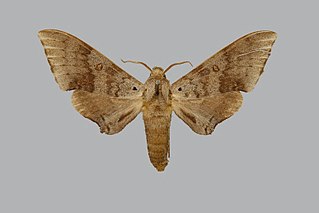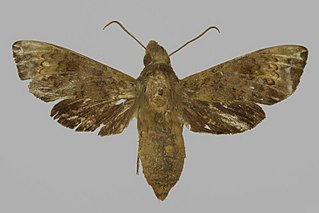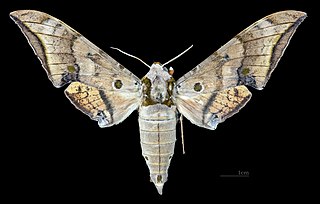
Pseudenyo is a genus of moths in the family Sphingidae, consisting of one species, Pseudenyo benitensis, which is found from Nigeria to Gabon.

Antinephele is a genus of moths in the family Sphingidae erected by William Jacob Holland in 1889.

Platysphinx stigmatica is a moth of the family Sphingidae. It is known from forests from Nigeria to the Congo, Angola and western Uganda.

Antinephele achlora is a moth of the family Sphingidae. It was described by William Jacob Holland in 1892, and is found from forests from Sierra Leone to Uganda and western Kenya.

Antinephele anomala is a moth of the family Sphingidae. It was described by Arthur Gardiner Butler in 1882 and is known from Ivory Coast and Nigeria. It is considered most similar to Antinephele achlora.

Neopolyptychus prionites is a moth of the family Sphingidae. It is known from lowland forests and heavy woodland from Guinea to the Congo and western Uganda.

Antinephele camerounensis is a moth of the family Sphingidae. It was described by Benjamin Preston Clark in 1937 and is found from Gabon to the Central African Republic, Uganda and Kenya.

Antinephele efulani is a moth of the family Sphingidae. It was described by Benjamin Preston Clark in 1926 and is known from the Democratic Republic of the Congo, Gabon and Cameroon.

Antinephele lunulata is a moth of the family Sphingidae. It was described by Rothschild and Jordan in 1903, and is known from forests and wooded habitats from Sierra Leone to Cameroon, the Democratic Republic of the Congo, Zambia, Zimbabwe and Tanzania, as well as Madagascar.

Antinephele marcida is a moth of the family Sphingidae. It was described by William Jacob Holland in 1893, and is found from forests from Cameroon to Uganda and western Kenya.

Sphingonaepiopsis ansorgei is a moth of the family Sphingidae. It is known from open habitats from northern South Africa to East Africa in the east and to Angola in the west.

Odontosida magnificum is a moth of the family Sphingidae. It is known from South Africa and Zimbabwe.

Leucostrophus commasiae is a moth of the family Sphingidae. It is known from west Africa to Gabon and to Kasai in south-western Congo .

Antinephele muscosa is a moth of the family Sphingidae. It is found from Ghana to Gabon.

Temnora funebris is a moth of the family Sphingidae first described by William Jacob Holland in 1893. It is known from the forests of western Africa to the Democratic Republic of the Congo, Uganda, Tanzania and Zimbabwe.

Nephele peneus is a moth of the family Sphingidae. It is known from forests and woodland from Senegal to East Africa, Angola and Delagoa Bay.

Ambulyx liturata is a species of moth of the family Sphingidae first described by Arthur Gardiner Butler in 1875.

Ambulyx sericeipennis, the common gliding hawkmoth, is a species of moth of the family Sphingidae first described by Arthur Gardiner Butler in 1875. It is found from northern Pakistan and northern India eastwards across Nepal, Sikkim, Bhutan, Myanmar, Thailand, Laos, Cambodia and Vietnam to central and southern China and Taiwan.

Ambulyx maculifera is a species of moth of the family Sphingidae. It is known from India.

















